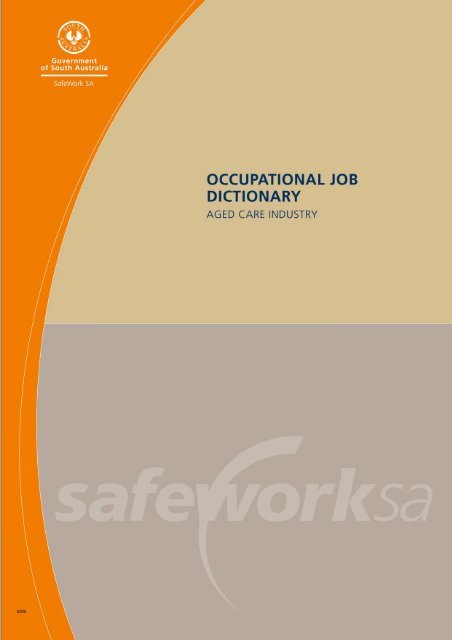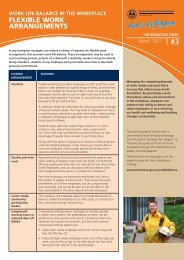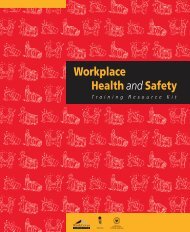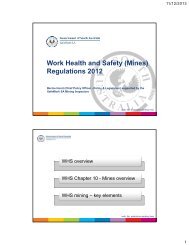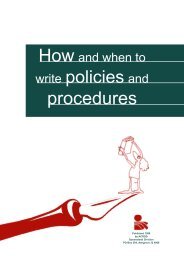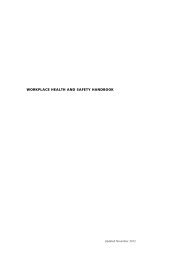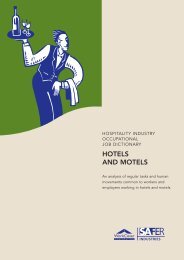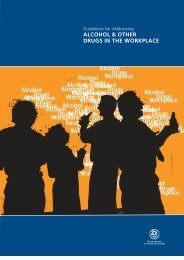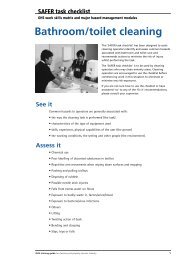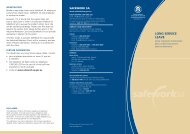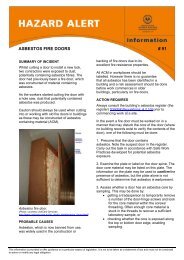aged care industry job dictionary - SafeWork SA - SA.Gov.au
aged care industry job dictionary - SafeWork SA - SA.Gov.au
aged care industry job dictionary - SafeWork SA - SA.Gov.au
You also want an ePaper? Increase the reach of your titles
YUMPU automatically turns print PDFs into web optimized ePapers that Google loves.
0295AGED CARE INDUSTRY JOB DICTIONARY1
OCCUPATIONAL JOB DICTIONARY – AGED CARE INDUSTRYAn analysis of regular tasks and human movements common to workers and employers workingin the <strong>aged</strong> <strong>care</strong> <strong>industry</strong>.Design and produced by <strong>SafeWork</strong> <strong>SA</strong> and WorkCover Corporation of South Australia.www.safeworksa.sa.gov.<strong>au</strong>www.workcover.comDISCLAIMERThe information produced by <strong>SafeWork</strong> <strong>SA</strong> and WorkCover Corporation of South Australia in this publication is correct at the time of printing and isprovided as general information only. In utilising general information about workplace health and safety and injury management, the specific issuesrelevant to your workplace should always be considered. This publication is not intended as a substitute for the requirements of the WorkersRehabilitation and Compensation Act, 1986 or the Occupational Health Safety and Welfare Act 1986.LIMITATIONS OF LIABILITYTo the best of our knowledge, the procedures described in this document reflect currently accepted practice, but cannot be considered absolute anduniversal recommendations. All recommendations must be considered in view of the specific example and new information that has become availablesince the time of writing. The <strong>au</strong>thors disclaim responsibility and assume no liability for any adverse affects resulting directly or indirectly from thesuggested procedures, from any undetected errors, or from the reader’s misunderstanding of the text.AGED CARE INDUSTRY JOB DICTIONARY2
CONTENTSIntroduction• Glossary of Terms and Abbreviations• Relevant Legislation• Key definitions: Rating Structures of Physical Demands• Physical demands – Strength Rating• Frequency of Work• Table 1. Physical demands – Strength Rating and Frequency of work• Table 2. Physical Demands Factors• Diagram 1: Grip Positions of the hands/fingers• Diagram 2: Positions of the hand and arm• Diagram 3: Seated Working PostureCare Worker – CommunityCare Worker – Residential CareCleaner – DomesticClerical OfficerCommercial Kitchen StaffDiversional TherapistEnrolled NurseGardener/Handy PersonHealth and Fitness CoordinatorHealth and Fitness LeaderIT WorkerL<strong>au</strong>ndry WorkerMaintenance WorkerPodiatristRegistered NurseReferences and BibliographyAGED CARE INDUSTRY JOB DICTIONARY3
HOW TO USE THIS DICTIONARY FOR:THE AGED CARE INDUSTRYWelcome to the Aged Care Industry Job Dictionary. You can customise the <strong>dictionary</strong> by using your computer and/orthe disk provided. Please download the occupations relevant to your organisation from the website or CD ROM. Arange of occupations relevant to <strong>aged</strong> <strong>care</strong> are listed, however not all may be relevant to your organisation.You can either add or omit information to tailor a <strong>job</strong> description within your organisation. You may even wish toattach some additional photographs. Ensure that the work attributes section that lists the frequency of activities isupdated. The columns on ‘time spent per day’ and ‘repetitions per day’ may need to be modified accordingly for yourparticular organisation. Work mechanics/ergonomics may change from time to time and from <strong>job</strong> to <strong>job</strong>, therefore thehuman factors sections (such as heights, reaches, rest breaks, safety gadgets etc.) may need regular updates.REHABILITATION PURPOSES• Find and download the occupational description for the injured worker from the software, eg, an enrolled nurse’s<strong>job</strong> description could be downloaded and printed.• Ensure the task matches the duties performed or else modify the script accordingly prior to printing.• Either fax or email this information to the treating medical practitioner if requested by the rehabilitation provider.• Identify suitable tasks from within the range of duties for the injured worker to commence work, with the agreementof the treating medical practitioner and, if involved, the rehabilitation provider.• Agree on how to update/increase the injured worker’s duties; or seek an occupational therapist’s orphysiotherapist’s guidance to outline the duties program. If the worker is unable to undertake their pre-injuryduties, you as an employer could offer alternative duties from within this <strong>job</strong> <strong>dictionary</strong>. This process ensuresreduction in income maintenance costs and the development of secondary conditions.• User-friendly software could be developed to assist employers inexperienced in management of workerscompensation and identification of suitable duties. Such software may assist in fast-tracking a worker’s early returnto suitable duties based on the nature of the worker’s injury/condition. This information is to be forwarded to thetreating medical practitioner.AS A PREVENTATIVE TOOL FOR PRE-EMPLOYMENT ASSESSMENTS• The assessing medical practitioner has an overview of general <strong>job</strong> demands and may be able to use it to establishsuitable medical assessments. These are then used to determine a worker’s suitability for the given <strong>job</strong>.• A Functional Capacity Evaluation (FCE) could be conducted where tests could be modified to match with therequired <strong>job</strong> demands. Objective measurements of the workers’ capacities and limitations are compared with thephysical demands of the <strong>job</strong> in question.• Some employers may prefer to do a more specific task analysis prior to the development of a pre-employmentassessment for their workplace.AGED CARE INDUSTRY JOB DICTIONARY4
EDUCATION PROGRAMS• The Job Dictionary can be used in education programs to:• demonstrate correct and incorrect work practices, using the photos taken during the Job Dictionary preparations• prepare a data show in conjunction with the basic anatomy/bio-mechanics and medical information, which cansubsequently be printed into a small booklet for in-house training programs.DEVELOPING POLICY INFORMATION• Feedback from workers and supervisors should be collected and analysed following the education programs. Thisfeedback should then be listed as positive and unsafe work habits. All parties must then reach an agreement as towhich work practices should be undertaken for the future. The education program would have highlighted themedical and subsequent administrative consequences of non-compliance to these agreed work practices.• This information could be regularly updated via an in-house provider or an external advisor.AN ADDITION TO OHSW AUDITS• Information collated during Job Dictionary assessments can be forwarded to the in-house OHS adviser or anexternal adviser.• The information can be used as part of a risk management process, as a basis for developing safer workprocesses.AGED CARE INDUSTRY JOB DICTIONARY5
PREFACEACKNOWLEDGEMENTSThe <strong>SA</strong>fer Aged Care Industry OHS Committee gratefully acknowledges the concept of the Job Dictionary (for theHospitality Industry) prepared by Mr Nandu Nandoskar of NN Associates. The original concept of this Job Dictionaryhas been reproduced, and developed herein, by the following to whom we also express our gratefulacknowledgements:Glenn Fox; Chair, Aged Care Injury Management Steering CommitteeLydia Ksiazkiewicz; LK Consultancy, Academic ReviewThe Aged Care Job Dictionary Sub-committee:Sue Balde, Helping Hand Aged CareMary Hill, Safe Work PracticeNaomi Lea, WorkCover CorporationIngrid Ormay, <strong>SafeWork</strong> <strong>SA</strong>Denise Palmer, Department of HealthThe Aged Care Job Dictionary Pilot Group:Tracey Abraham, RDNSMelissa Berridge, QBE Workers CompensationP<strong>au</strong>l Dewing, Dewing Ergonomics & Safety Pty LtdGillian Elix, Flinders Medical CentreMary Hill, <strong>SafeWork</strong> PracticeSharon Holmes, LHMULinda Lewis, Metropolitan Domiciliary CareLisa Natale, Nandu Nandoskar Associates Pty LtdChris Racar, Elder<strong>care</strong>Denise Palmer, Department of HealthP<strong>au</strong>l Rothmore, Repatriation General HospitalJudith Sheidow, Life<strong>care</strong> Churches of ChristAndrea Trainer, Allianz Australia Workers CompensationPhotos:Department of Health, ECH Inc, Helping Hand Aged Care, Royal Sun Alliance, <strong>SafeWork</strong> Practice,AGED CARE INDUSTRY JOB DICTIONARY6
GLOS<strong>SA</strong>RY OF TERMS AND ABBREVIATION<strong>SA</strong>bduction: Movement of a body part away from the median plane (of the body, in the case of the limbs; of the handor foot, in the case of digits).Adduction: Movement of a body part toward the median plane (of the body, in the case of the limbs; of the hand orfoot, in the case of digits).ASCO: Australian Standard Classification of OccupationsBending: To force into a different or particular, especially curved, shape, as by pressure.Biceps: A muscle with two origins or heads. Commonly used to refer to the biceps brachii muscle.Carpal tunnel: Channel on the palmar side of the wrist formed by the irregular small bones of the wrist and toughligament stretched across it. The flexor tendons of the fingers, the median nerve, and some blood vessels passthrough the carpal tunnel.Deltoid: Large muscle of the shoulder that abducts and otherwise moves the upper arm about the shoulder jointagainst external loads.Distal: Situated away from the centre of the body, or from the point of origin; specifically applied to the extremity ordistant part of a limb or organ.Dorsiflexion: Turning upward of the foot or toes or of the hand or fingers.Dynamic: The science of motion in response to forces.Ergonomics: A branch of ecology concerned with human factors in the design and operations of machines and thephysical environment.Extension: The act of bringing the distal portion of a joint in continuity (though only parallel) with the long axis of theproximal portion.Flexion: The act of flexing or bending, e.g. bending of a joint so as to approximate the parts it connects.Force: That which tends to produce motion in a body.Frontal plane: In front; relating to the anterior part of a body.Goniometer: A calibrated device designed to measure the arc or range of motion of a joint.Gross: Gripping: Grasping, seizing, holding with a large finger span.Isometric: In physiology, denoting the condition when the ends of a contracting muscle are held fixed so that thecontraction produces increased tension at a constant overall length.Job: A set of tasks designed to be performed by one individual in return for a wage or salary.Kyphosis: A deformity of the spine characterised by extensive flexion.Lordosis: An abnormal extension deformity; anteroposterior curvature of the spine, generally lumbar with theconvexity looking anteriorly.Lumbar: Relating to the loins, or the part of the back and sides between the ribs and the pelvis.Lumbosacral joint: Joint between fifth lumbar vertebra and sacrum.Medial: Relating to the middle or centre; nearer to the median or midsagittal plane.Median Nerve: A large important nerve that activates muscles that pronate the forearm and flex forearm, wrist andfingers. The sensory part of the nerve provides feedback information from the thumb and the first two and one halffingers.Occupation: A set of <strong>job</strong>s with similar sets of tasks.Plantar flexion: Bending about the ankle joint in the direction of the sole of the foot.Prehensile: Adapted for taking hold of or grasping.Pronation of the forearm: Rotation of the forearm in such a way that the palm of the hand faces backward when thearm is in the anatomical position, or downward when the arm is extended at a right angle to the body.AGED CARE INDUSTRY JOB DICTIONARY7
Proximal: Nearest the trunk or the point of the origin, said of part of a limb.Pulmonary: Pertaining to the lung.Range of motion: The range of translation and rotation of a joint for each of its degrees of freedom.Rotation: Turning or movement of a body round its axis.Scoliosis: Abnormal lateral curvature of the vertebral column (spine).Stiffness: Rigid or firm in substance; not flexible, pliant or easily bent.Strain: To make an effort to the limit of ones strength; or, the change in shape that a body undergoes when actedupon by an external force.Stress: The force or pressure applied or exerted between portion of a body or bodies, generally expressed in poundsper square inch.Supination: Supination of the forearm: Rotation of the forearm in such a way that the palm of the hand faces forwardwhen the arm is in the anatomical position, or upward when the arm is extended at a right angle to the body.Tendinitis: Also tendonitis, inflammation of tendon (including tendon sheath).Tendon: A fibrous cord or band of variable length that connects a muscle with its bony attachments.Tendon sheaths: A sheath of synovial membrane enveloping certain of the tendons.Torsion: Twisting or rotation of a part upon its long axis.Transverse: Crosswise; lying across the long axis of the body.Triceps: Three-headed large extensor muscle of the upper arm. Originates from the back of the humerus and theshoulder blade and inserts into the proximal tip of the ulna.Work: That which is accomplished when a force acts against resistance to produce motion.AGED CARE INDUSTRY JOB DICTIONARY8
RELEVANT LEGISLATION:THE OCCUPATIONAL HEALTH <strong>SA</strong>FETY AND WELFARE ACT, 1986• sets out general requirements which apply to all workplaces in South Australia• defines the duties of employers and other people who may affect the work place, e.g. architects, builders,suppliers, manufacturers• sets out the rights and responsibilities of workers• establishes the roles of OHS&W Committees and Health and Safety representatives• is based on consultation and participation.THE OCCUPATIONAL HEALTH <strong>SA</strong>FETY AND WELFARE REGULATIONS, 1995• are specific in legal requirements on certain issues• normally related to a particular hazard or activity, e.g. manual handling• may be administrative, e.g. injury reporting• in the case of manual handling, prescribe process that must be followed to achieve a minimum standard ofoccupational health and safety in the workplace.THE MANUAL HANDLING APPROVED CODE OF PRACTICE• provides preferred methods or courses of action on how to achieve particular standards of health and safety• is more flexible than the Regulations in the way tasks are performed• usually covers the same topics as the Regulations• provide guidance on how to achieve levels of health and safety as required by the specific Regulations.AGED CARE INDUSTRY JOB DICTIONARY9
DIAGRAM 1. GRIP POSITIONS OF THE HANDS/FINGERSCylindricalBall/sphericalHookPalmar Pinch Key/lateral PincerAGED CARE INDUSTRY JOB DICTIONARY10
DIAGRAM 2. POSITIONS OF THE HAND AND ARMUlnar deviationNeutralRadial deviationAbductionPronationSupinationNeutralAdductionExtensionFlexionNeutralAGED CARE INDUSTRY JOB DICTIONARY11
RATING STRUCTURES OF PHYSICAL DEMANDSThe criteria for the <strong>job</strong> analysis have been obtained from the United States Department of Labor, Dictionary ofOccupational Titles (DOT), Fourth Edition, Revised 1991.The Australian Standard Classification of Occupations (ASCO) does not define <strong>job</strong>s in terms of their physicaldemands.Therefore, the DOT ratings have been and continue to be widely used in Australia as a basis for defining the physicaldemands of <strong>job</strong>s.PHYSICAL DEMANDS – STRENGTH RATINGThe strength factor is expressed by one of five terms: Sedentary, Light, Medium, Heavy and Very Heavy.TABLE 1. PHYSICAL DEMANDS – STRENGTH RATING AND FREQUENCY OF WORKFrequency ofPhysical demand strength ratingworkSedentary Light Medium Heavy Very heavyOccasional Up to 5kgs Up to 9kgs 9-23kgs 23-45kgs >45kgsFrequent Negligible Up to 5kgs 5-11kgs 11-23kgs >23kgsConstant 0 Negligible Up to 5kgs 5-9kgs >9kgsSitting most of thetime; may involvewalking or standingfor brief periods.(1) Standing/walking toa significant degree; or(2) sitting most of thetime but entails pushingand/or pulling of arm orleg controls and/or(3) <strong>job</strong> requires workingat a production ratepace entailing constantpushing and/or pullingof materials, eventhough the weight isnegligible.Standing/walking to a significant degree forall categories. Medium to Very heavyThe strength factor rating refers to the force exerted to lift, carry, push, pull or otherwise move objects, including thehuman body.FREQUENCY OF WORKOccasionally: Activity or condition exists to 1/3 of the time (0-33%)Frequently: Activity or condition exists from 1/3 to 2/3 of the time (34-66%)Constantly: Activity or condition exists 2/3 or more of the time (67-100%)For convenience, the percentages, noted in brackets (), have been widely used in describing frequency of work.AGED CARE INDUSTRY JOB DICTIONARY12
TABLE 2. PHYSICAL DEMANDS FACTORSBALANCING Maintaining body equilibrium to prevent falling when walking, standing, crouching orrunning on narrow, slippery, or erratically moving surfaces.CARRYINGCLIMBINGCRAWLINGCROUCHINGFEELINGFINGERINGHANDLINGKNEELINGLIFTINGPULLINGPUSHINGREACHINGSITTINGSTANDINGSTOOPINGWALKINGTransporting an object, usually holding it in the hands or arms or on the shoulder.Ascending or descending ladders, stairs, scaffoldings, ramps, poles and the like; using feetand legs, and/or hands and arms.Moving about on hands and knees or hands and feet.Bending body downward and forward by bending legs and spine.Perceiving attributes of objects, such as size, shape, temperature, or texture, by touchingwith skin, particularly that of fingertips.Picking, pinching, or otherwise working primarily with fingers rather than with the wholehand or arm as in handling.Seizing, holding, grasping, turning or otherwise working with the hand or hands. Fingers areinvolved only to the extent that they are an extension of the hand.Bending legs at knees to come to rest on knee or knees.Raising or lowering an object from one level to another – includes upward pulling.Exerting force upon an object so that the object moves toward the force (includes jerking).Exerting force upon an object so that the object moves away from the force (includesslapping, striking, kicking, and treadle actions).Extending hand(s) and arm(s) in any direction.Remaining in the normal seated position.Remaining on one’s feet in an upright position at a workstation without moving about.Bending body downward and forward by bending spine at the waist. This factor is importantif it occurs to a considerable degree and requires full use of lower extremities and backmuscles.Moving about on foot.AGED CARE INDUSTRY JOB DICTIONARY13
DIAGRAM 3: GOOD WORK STATION PRINCIPLES AND EFFICIENT SEATED WORKINGPOSTUREAGED CARE INDUSTRY JOB DICTIONARY14


